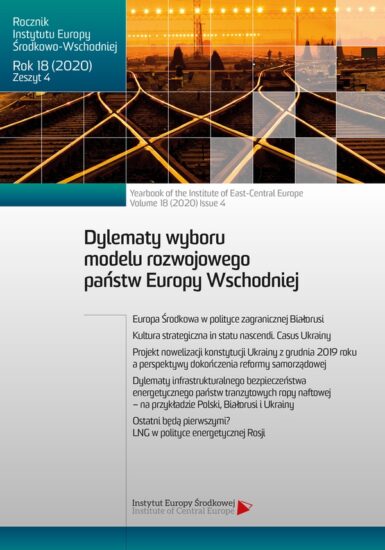Cooperation of “municipalities bagel” on the economic level. Outline of the problem
ORCID: Lech Jańczuk: 0000-0003-2578-1520
Strony: 247-259
Wydanie: Lublin 2020
DOI: https://doi.org/10.36874/RIESW.2020.4.11
Sposób cytowania: L. Jańczuk, Współpraca gmin obwarzankowych na płaszczyźnie gospodarczej. Zarys problemu, „Rocznik Instytutu Europy Środkowo-Wschodniej” 18(2020), z. 4, s. 247–259, DOI: https://doi.org/10.36874/RIESW.2020.4.11.
Słowa kluczowe: administracja, działalność gospodarcza, gminy, gminy obwarzankowe
Abstrakt:
There are “urban-rural municipalities” in Polish administration nomenclature. They are territorial units where urban and rural areas have one name and one local government. There are also urban and rural municipalities that have one name but different local governments. That neighborhood of municipalities in Polish may be described as “municipalities bagel”.
The aim of this article was to investigate whether and to what extent the “municipalities bagel” cooperate (coordinate) the exercising public tasks on the economic level. The article attempts to verify the research hypothesis: in “municipalities bagel” there is a lack of coordination of the exercising public tasks”.
The research method was a diagnostic survey in which the questionnaire was conducted. In December 2019, questionnaire forms were sent to all “municipalities bagel” in Poland.
The results of the research indicated a lack of coordination in the performance of public tasks between “municipalities bagel”. The result is a reduction of the efficiency of performance of public duties in such municipalities. The “municipalities bagel” are functionally related areas. This link is characterized by the subordination of the interests of the rural municipality (especially economic). The development of bagel rural communes is determined by the development and cooperation with their urban counterparts.
Bibliografia:
Baza teleadresowa Jednostek Samorządu Terytorialnego, http://administracja.mswia.gov.pl/adm/baza-jst/baza-teleadresowa-jst-d/7788,Baza-teleadresowa-JST-do-pobrania.html.
Jańczuk L., Samodzielność jednostek samorządu terytorialnego jako podmiotów administracji publicznej w Polsce, Lublin 2013.
Konstytucja Rzeczypospolitej Polskiej z dnia 2 kwietnia 1997 roku, art. 16 ust. 2 (Dz. U. 1997, nr 78 poz. 483).
Ocena sytuacji samorządów lokalnych, Ministerstwo Administracji i Cyfryzacji, Warszawa 2013, http://eregion.wzp.pl/sites/default/files/ocena-sytuacji-samorzadow-lokalnych.pdf.
Polskie obwarzanki, Ministerstwo Administracji i Cyfryzacji, Warszawa 2013, http://www.lzg24.pl/sites/default/files/ministerstwo.pdf.
Rozporządzenie Rady Ministrów z 15 grudnia 1998 r w sprawie szczegółowych zasad prowadzenia, stosowania i udostępniania krajowego rejestru urzędowego podziału terytorialnego kraju oraz związanych z tym obowiązków organów administracji rządowej i jednostek samorządu terytorialnego (Dz. U. 1998, nr 157 poz. 1031).
Ustawa z dnia 20 grudnia 1996 r. o gospodarce komunalnej (Dz. U. 1997, nr 9 poz. 43, tj. Dz. U. 2019 poz. 712).
Ustawa z dnia 24 lipca 1998 roku o zmianie niektórych ustaw określających kompetencje organów administracji publicznej (Dz. U. 1998, nr 106 poz. 668) oraz ustawa z dnia 29 grudnia 1998 roku o zmianie niektórych ustaw w związku z wdrożeniem reformy ustrojowej państwa (Dz. U. 1999, nr 162 poz. 126).
Ustawa z dnia 5 czerwca 1998 roku o samorządzie powiatowym, art. 6 ust. 2. (Dz. U. 1998, nr 91 poz. 578, tj. 2020 poz. 920).
Ustawa z dnia 8 marca 1990 roku o samorządzie gminnym art. 6 (Dz. U. 1990, nr 16 poz. 95, tj. 2020 poz. 713).
Słowa kluczowe: administracja, działalność gospodarcza, gminy, gminy obwarzankowe
PDF: Pobierz